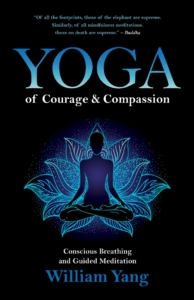YOGA OF COURAGE AND COMPASSION
Conscious Breathing and Guided Meditation
by William Yang
Inner Traditions
Pub date: 06-July-2021
AMBER LOVE 25-MAY-2021 This review is a courtesy provided by NetGalley. To support this site and my other work, please consider being a monthly donor at Patreon.com/amberunmasked; you can also buy my books through Amazon (or ask your local retailer to order you copies). I’m also an Amazon Influencer so you can shop through my lists of recommended products.
Publisher’s summary:
Lessons in fearless living through breathwork, gentle movement, and meditation based on the experiences of those at the edge of life
• Shares a series of simple, practical, and profound conscious breathing, movement, and meditation exercises that help you bypass the ego-centered mind, open your heart, and live in the present moment
• Developed through the author’s decades of work with cancer patients
Through decades of teaching yoga and meditation to cancer patients, William Yang witnessed hundreds of breakthroughs into radical presence and openheartedness. In many ways, his patients taught him more than he taught them. From this collaboration with the sick and dying, Yang developed a series of simple, practical, and profound conscious breathing, movement, and meditation exercises that help to bypass the ego-centered mind, open the heart, and live fearlessly in the present moment.
Yang’s exercises begin with an invitation to rediscover a natural and unforced way of breathing, so we can let go of our anxious ego and let life in again. From there, enlarging the sequence step by step, the author focuses on grounding and connecting with Mother Earth, working with the spine to develop a new sense of self-confidence, and opening the heart to love again.
As we shed elements of the stressed, anxious person we once were, we are able to be more attuned to the world around us in a loving and caring way. Through the lessons learned from his cancer patients, Yang shows how, with courage and compassion, we can live and love without reservation at any time in our lives.
Review:
The main thing about Yoga of Courage and Compassion is that it is a quick reference directed to Christians, it seems, who may be looking for relatability in Buddhist pranayama (breathing yoga) and meditation. I personally don’t think anyone outside Christianity or Buddhism will get as much out of the text; however, the instructions for meditating are secular for the most part and embrace Yoga’s universality.
Author William Yang is certainly notable, but for someone with his voluminous amount of experience, I expected a lot more depth. You won’t be getting a text book like Bessel vanderKolk or Stephen Porges explaining any science connection to the mind-body experience here. Yet, Yang’s experience is “decades of teaching yoga and meditation to cancer patients.” His work is considered so notable in the Netherlands and India that he became a knight of the order of Oranje Nassau bestowed by Queen Beatrix. Needless to say, I expected more than what feels like notes taken during a weekend Yoga retreat on pranayama.
I found pleasurable passages and useful bits throughout. I just don’t think the book matches the advertising as a book on courage and compassion when it focuses so much on how two large religions have common ground in non-duality.
If you’re a believer in dualism, then I would definitely not recommend this book unless you’re looking for a tiny bit of insight (and I mean tiny). This book I would recommend, again, only to yoga teachers or those leading a Bible study/Xian workshop who are also interested in seeing where their non-dualism intersects with ONE specific type of Buddhism from the Tibetan School of Mahayan Buddhism.
The illustrations started out confusing though beautiful in singular inked brush strokes like Japanese silk painting. They get better by chapter three where you are shown more details and can make out the human figure easily.
Each chapter follows a formula:
- The text to explain the intersection of the two religions regarding that chapter’s theme (letting go, emptiness, accepting compassion, et al.).
- Then it has the breathing and meditation exercises. First if “Buddha’s Basic Breathing Meditation” of taking 10 cycles of breath.
- Then the following meditations vary slightly from chapter to chapter but follow a formula of including small movements, mudras, sounds, and visualization.
3 stars may seem harsh, but I think the audience for this is so niche that it’s not something people seeking guides on meditation will appreciate.

